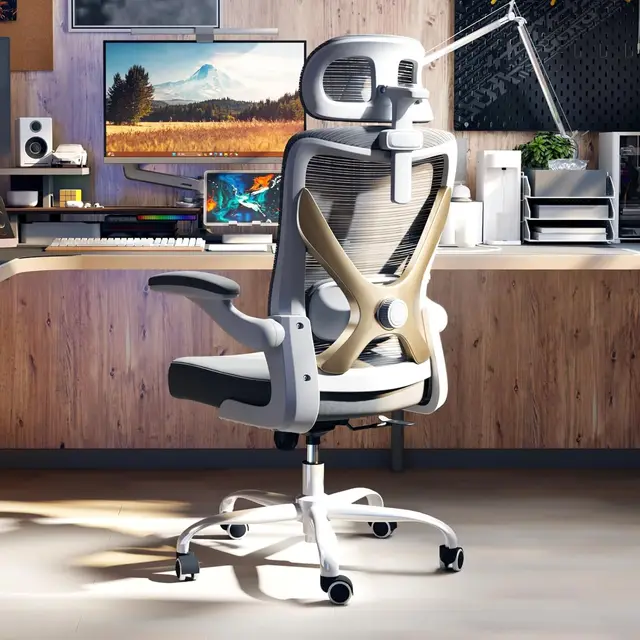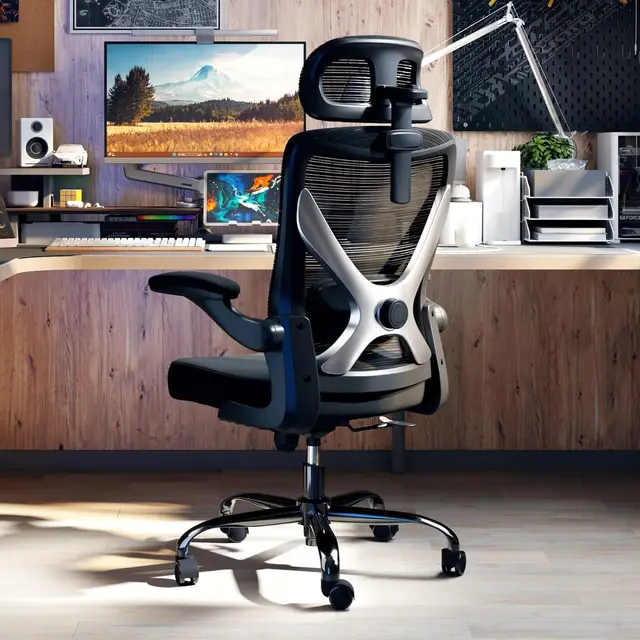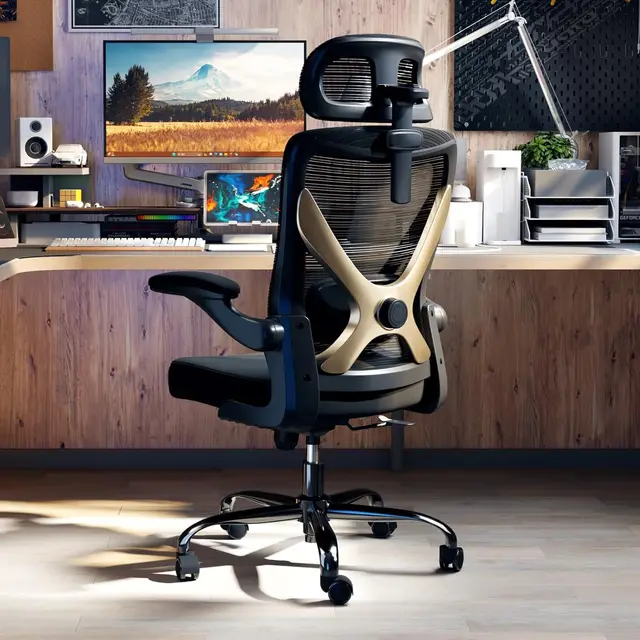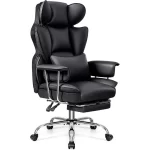Identifying the Problem: Why Office Chairs Sink
Discovering why your office chair keeps sinking is the first step to a fixed workspace. Office chairs typically use a pneumatic cylinder that controls the height. Over time, the gas pressure that holds the chair up can fail. This is often due to a broken seal within the cylinder. When this seal cannot maintain pressure, the chair lowers by itself. To fix your chair, it’s crucial to confirm this mechanism is the culprit. You might notice the chair slowly descends when you sit or won’t stay raised when you adjust it. These signs point to a worn-out cylinder as the cause of your sinking chair woes.
DIY Method 1: Using a Hose Clamp and Duct Tape
Step-by-Step Guide
A common and quick fix to a sinking office chair involves using a hose clamp and duct tape. This DIY method is straightforward and can be completed with items you might already have at home. Here’s a simple guide on how to execute this repair.
- Step 1: Adjust Chair to Desired Height: Firstly, lift your chair to the height that best suits your desk and comfort level. Ensure it’s at the perfect position for your ergonomic needs.
- Step 2: Secure Hose Clamp: Find a hose clamp—size 20 or around 13/16″ to 1-3/4″ in diameter. Place the clamp at the base of the chair’s cylinder; this will act as a stopper to prevent it from sinking.
- Step 3: Apply Duct Tape: For additional grip, wrap the area where the clamp will go with duct tape. This helps the clamp to securely hold its position.
- Step 4: Tighten Clamp: Now, tighten the hose clamp until it firmly grips the cylinder. Be careful not to over-tighten as this might damage the cylinder or the clamp.
- Step 5: Test Chair Stability: Finally, sit on the chair to test if it maintains the set height. If it holds, your fix is successful. If not, adjust the tightness of the clamp and check again.
While this method is cost-effective and immediately actionable, it’s important to remember that it serves as a temporary fix. The chair won’t be able to adjust in height once the clamp is in place, and the aesthetic might not suit all environments. Nevertheless, this solution can buy you some time before you decide on a more permanent fix or a replacement chair.

DIY Method 2: Using PVC Pipe
Step-by-Step Guide
If your office chair keeps sinking, another fix you can try is using PVC pipe. This DIY method may take a bit more effort than the hose clamp, but it’s still quite easy to do. Here’s a step-by-step guide:
- Step 1: Measure the Cylinder: First, measure the chair’s cylinder at your preferred height. Make sure you note the diameter as well.
- Step 2: Cut PVC Pipe: Find a PVC pipe wider than the cylinder. Cut the pipe to the length you measured.
- Step 3: Split the Pipe: Use a saw to cut the PVC pipe lengthwise. This allows it to fit around the cylinder.
- Step 4: Fit Pipe onto Cylinder: Attach the cut pipe onto the cylinder. It should fit snugly around it.
- Step 5: Adjust and Check: Finally, sit on the chair to see if it stays at the right height. You can add or remove sections of PVC pipe to adjust the height if needed.
This DIY fix is more durable than the hose clamp and allows for slight adjustments in height. However, it is still a temporary solution and might not match the professional look of your workspace. Before applying this method, ensure you have the right tools and PVC pipe size for a secure fit.
Professional Approach: Replacing the Cylinder
Replacing the cylinder is a more professional and permanent fix. Here’s how you do it:
- Step 1: Purchase a Replacement Cylinder: Make sure to buy a cylinder that fits your chair model.
- Step 2: Remove the Old Cylinder: Use tools like a wrench or a cylinder removal kit. Follow safety procedures.
- Step 3: Install the New Cylinder: Attach the new cylinder to the chair base and seat. Ensure it’s secure.
- Step 4: Test the Chair’s Movement: Adjust the chair height to check the new cylinder’s function.
- Step 5: Final Check for Stability and Comfort: Sit on the chair to make sure it feels stable and comfortable.
This solution may cost more than a DIY fix, yet it offers a return to full functionality. A new cylinder allows for height adjustments and maintains the chair’s professional look. It often comes with a warranty, adding peace of mind. For those not comfortable with DIY repairs, or if the chair is high-value, replacing the cylinder is recommended.

Temporary vs Permanent Fixes: Pros and Cons
When dealing with a sinking office chair, you can choose between temporary and permanent fixes. Each option has its pros and cons.
Pros of Temporary Fixes
Temporary fixes are quick and cheap. They can be easy to apply without special skills. These methods can quickly make a chair usable.
Cons of Temporary Fixes
However, temporary solutions are not lasting. Your chair might require frequent re-fixes. They may not offer height adjustments later. Also, these methods might not look professional.
Pros of Permanent Fixes
Permanent solutions restore full functionality of the chair. They allow for height adjustments. Once done, you don’t have to worry about recurrent issues.
Cons of Permanent Fixes
Permanent fixes like replacing the cylinder can be expensive. They might require specific tools and some technical knowledge.
In conclusion, consider how long you need the fix to last and budget constraints. Think about whether you’re comfortable with a DIY approach or need a professional touch.

Prevention Tips: Avoid Another Sinking Chair
To prevent your office chair from sinking again, follow these practical tips:
- Check Regularly: Inspect your chair’s cylinder and levers often. Early detection of wear can save time and effort.
- Be Gentle: Avoid rough use, such as dropping heavily into your chair. Treat it with care to extend its life.
- Correct Usage: Use the chair as intended. Do not stand on it or use it as a step ladder.
- Limit Weight: Stick to the weight limit recommended by the manufacturer. Overloading can cause premature wear.
- Keep it Clean: Regular cleaning can prevent dirt from damaging the chair’s mechanisms. Use suitable cleaning agents.
- Cover the Cylinder: Consider using a plastic cover around the cylinder to keep dust and dirt out.
- Regular Maintenance: Tighten any loose screws or bolts. Lubricate moving parts as needed to keep them running smoothly.
By following these tips, you can maximize the lifespan of your office chair and avoid recurring sinking issues.
Alternative Options: When to Consider a New Office Chair
While DIY fixes provide temporary relief, sometimes a new office chair is the best option. Consider upgrading if your office chair is old or continues to break despite repairs. New chairs offer updated features and warranties that extend their lifespan and functionality. Moreover, they can bring a fresh aesthetic and ergonomic alignment to your workspace that older models may lack. Measure your current chair’s shortcomings against the potential benefits of a new investment to make an informed decision.
Signs That You Need a New Office Chair
- Frequent Repairs: If you’re regularly fixing your chair, it might be time for an upgrade.
- Visible Wear and Tear: Cracks, sagging, and worn materials are clear indicators.
- Outdated Design: Newer models provide better ergonomics and features.
- Unhandled Sinking Issues: If adjustments or fixes no longer help, consider a replacement.
- Comfort Declined: If you can’t sit comfortably for long, your productivity could suffer.
Investing in a new office chair can rejuvenate your workspace and improve your daily comfort and productivity. Ensure the new chair meets your ergonomic needs and check for warranties for added security.


